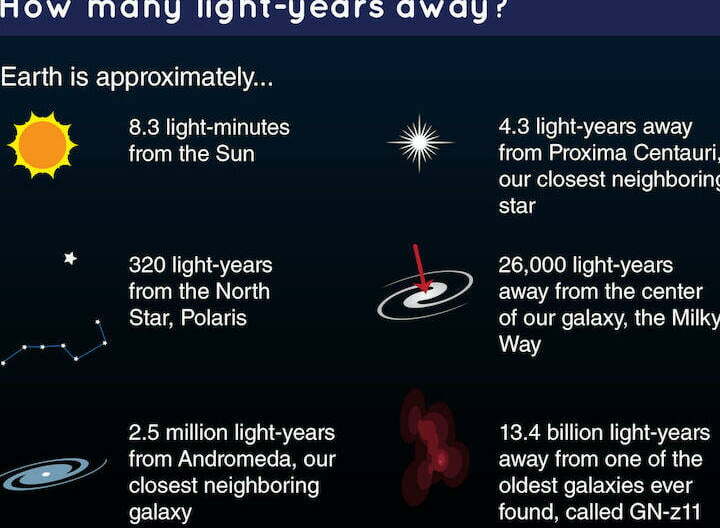The vast distances between stars are so immense that trying to measure them in terms of kilometers or miles would result in a never-ending string of zeros. To address this, astronomers have developed alternative units of measurement specifically for astronomical distances. For instance, the minimum distance between Earth and Mars is said to be 55.76 million kilometers. However, when it comes to the distances between stars, things become even more complex, and astronomers commonly use units such as light-years and parsecs.
An Astronomical unit is a unit of measurement used for objects within the Solar System and nearby objects in the Universe. It is defined as 149,598,100 kilometers (+- ~750 km), which is roughly equivalent to the average distance between the Earth and the Sun. Recent observations have observed a gradual increase in this value at a rate of 15 centimeters per year, which is believed to be caused by the Sun potentially losing mass due to the solar wind.

A light-year is the measurement of the distance that light travels in the span of one year. In terms of meters, this equates to 9,460,730,472,580,800. Interestingly, the starlight we observe on a clear night has been on a journey to our planet for many centuries, with some of those stars no longer in existence.
A parsec, also known as the “parallax of an angular second,” represents the distance from which the average radius of the Earth’s orbit (perpendicular to the line of sight) is observed at an angle of one arc second. To put it simply, one parsec is equivalent to 3.26 light-years.
It is worth noting that in popular science and science fiction literature, the term light-year is commonly used, while parsecs are predominantly utilized in professional writings and research.
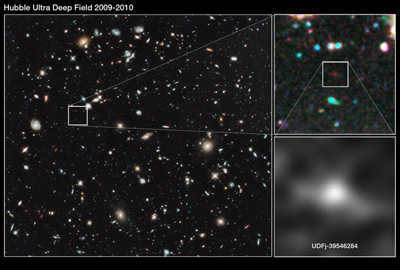
(Galaxy UDFj-39546284, located 13.3 billion light-years from Earth, can be seen as a small red dot in the image captured by the Hubble telescope )
The star closest to us, Alpha Centauri, is 4.37 light-years away from Earth. However, the most distant galaxy (as of December 2012) is a staggering 13.3 billion light-years away! This means that if the sun in this galaxy (known as UDFj-39546284) were to go out, humanity would not know about it for a very long time.
Throughout history, as people have explored their own planet, they have developed various systems for measuring distances. Eventually, it was decided to adopt the meter as a universal unit of length, and long distances are typically measured in kilometers.
However, as the 20th century approached, a new quandary emerged for humanity. Individuals commenced meticulously investigating the cosmos – and it transpired that the expanse of the Universe is so immense that kilometers are inadequate. The span between the Earth and the Moon or the Earth and Mars can still be quantified using conventional units. Nevertheless, if one endeavors to ascertain the distance in kilometers from our planet to the nearest star, the number expands exponentially, reaching an inconceivable magnitude of decimal places.
What is the equivalent of 1 light-year?
It became evident that the exploration of space necessitated a new unit of measurement, which led to the creation of the light-year. In a single second, light can travel a staggering distance of 300,000 kilometers. A light-year – represents the exact distance covered by light in the span of one year – in more conventional terms, that distance amounts to a staggering 9,460,730,472,580.8 kilometers. It is evident that using the succinct term “one light-year” is far more practical than having to incorporate this astronomical figure into calculations on a regular basis.
Incidentally, the concept of light years is instrumental in scientists’ quest to identify viable locations in the universe for potential intelligent life and determine the futility of sending radio signals in certain areas. This is because the speed of a radio signal is comparable to that of light, which means that a message sent towards a distant galaxy would take millions of years to reach its destination. It is more practical to anticipate a response from nearby “neighbors” – celestial bodies that could hypothetically transmit signals that would be detected by Earth’s instruments within a human lifespan.
How many Earth years is equivalent to 1 light year?
There is a common misconception that a light year is a unit of time. However, this is not the case. The term “light year” does not have any correlation with Earth years and is solely a measure of the distance that light can travel in one Earth year.
In astronomy, a light year is an off-system unit of length. It represents the distance that light can travel in one year. Specifically, 1 light year is equal to 0.3068 parsecs or 9.4605 × 10^15 meters. This information can be found in the Physical Encyclopedic Dictionary, edited by A. M. Prokhorov, published by Soviet Encyclopedia.
Another definition of a light year can be found in the Scientific and Technical Encyclopedic Dictionary. According to this source, a light year is the distance that light can travel in outer space or in a vacuum in one tropical year. This is equivalent to 9.4607 × 10^12 kilometers.
A light year is a unit of length used in astronomy. It is defined as the distance that light travels in one year, which is approximately 9.466 × 10^12 kilometers. For example, the distance to the nearest star, Proxima Centauri, is about 4.3 light years. The most distant stars in our Galaxy are located at… … … according to the Modern Encyclopedia.
In the context of interstellar distances, a light-year represents the distance that light travels in one year, approximately 9.46 × 10^12 kilometers, as stated in the Large Encyclopedic Dictionary.
The term “light-year” refers to the unit of length used in astronomy, which is the path traveled by light in one year, equivalent to 9.466 × 10^12 kilometers. The distance to the nearest star, Proxima Centauri, is approximately 4.3 light-years. The most remote stars in the Galaxy can be found… … … as described in the Illustrated Encyclopedic Dictionary.
An extrasystemic unit of length utilized in astronomy. A light-year represents the distance traveled by light in the span of one year. Specifically, a light-year is equivalent to 9.4605E+12 kilometers or 0.307 parsecs. This definition can be found in the Astronomical Dictionary.
A light-year is a unit of measurement for interstellar distances. It is defined as the distance that light travels in the course of one year, which is equal to approximately 9.46-1012 kilometers. This information can be found in the Encyclopedic Dictionary.
Light-year is a term used to describe a unit of distance that corresponds to the path traversed by light in a single year. Specifically, a light year is equal to 0.3 parsecs. This definition can be found in the Concepts of Modern Natural Science. Dictionary of basic terms.
Light year is an astronomical unit of length, equal to the distance that light travels in a vacuum in one tropical year. It is denoted by ly: 1 ly = 9.46073 × 1012 km.
Light year is a unit of length used in astronomy, defined as the distance that light travels in one year in a vacuum. It is denoted by ly: 1 ly = 9.46073 × 1012 km.
Books
- There is no turning back. A collection of three books written by Lukyanov Alexei and Naumov Ivan Sergeevich. The collection includes “Tsunami. Book one. Shakers of the earth” published in 1999. The story revolves around Egor and Yusya Kruglovs who are left without adult care and face a bleak future. Their disabilities make…
- Exciting Astronomy by Kachur Elena. About the book: In this highly anticipated new book, Chevostok and Uncle Kuzya embark on a journey to the observatory! They will have the opportunity to explore and learn about the fascinating celestial bodies that adorn our night sky. Join them as they…
This message caused a great deal of buzz in the media, with some even speculating that humanity is on the verge of establishing new settlements on the distant star. However, this is not the case. The distance of 40 light years is incredibly vast, encompassing an unimaginable number of kilometers!
We are familiar with the concept of the third space velocity from our physics studies. It represents the velocity that an object near the Earth’s surface needs to achieve in order to exit the solar system. This velocity is calculated to be 16.65 km/sec. Conventional spacecrafts are launched at a speed of 7.9 km/sec to enter orbit around the Earth. While a speed of 16-20 km/sec is within the realm of possibility using current Earth technologies, anything beyond that is still beyond our capabilities!
As of now, humanity has not yet developed the means to accelerate spaceships beyond speeds faster than 20 km/sec.
Let’s calculate the number of years it would take for a starship traveling at a speed of 20 km/sec to cover a distance of 40 light-years and reach the TRAPPIST-1 star.
One light-year is the distance traveled by light in a vacuum, and the speed of light is approximately 300,000 kilometers per second.
A spaceship created by humans travels at a speed of 20 km/sec, which is 15,000 times slower than the speed of light. It would take such a ship 600,000 years to cover 40 light-years!
An Earth-bound spaceship (with current technology) would take around 600 thousand years to reach the TRAPPIST-1 star! According to scientists, the existence of a reasonable human being on Earth is only 35-40 thousand years, but it would take as long as 600 thousand years to reach the star!
In the foreseeable future, advancements in technology will not enable humans to reach the TRAPPIST-1 star system. Despite the potential of promising yet non-existent engines such as ion propulsion, photon drives, or space sails, which could theoretically propel a spacecraft to speeds of 10,000 km/s, the journey to TRAPPIST-1 would still take approximately 120 years. While this timeframe may be considered acceptable for long-term hibernation or for multiple generations of settlers, it is important to note that these engines are currently only within the realm of science fiction.
Furthermore, even the closest stars remain beyond humanity’s reach, let alone the vast distances to stars within our own galaxy or other galaxies.
Our Milky Way galaxy spans approximately 100,000 light-years, which equates to an astonishing 1.5 billion years for a modern Earth ship to traverse from one end to the other! Scientific research indicates that our Earth is approximately 4.5 billion years old, with multicellular life emerging around 2 billion years ago. To put things into perspective, the distance to our nearest galaxy, the Andromeda Nebula, is a staggering 2.5 million light years away from Earth – a truly mind-boggling expanse!
It is clear that, given our current understanding, no individual currently alive will ever have the opportunity to set foot on a planet located near another star.
While the term “year” may sound similar to a unit of time, it is actually used to measure distance. Specifically, a light-year serves as a unit of measurement for vast spatial expanses.
The light-year represents a non-system unit of length, denoting the distance traveled by light in a vacuum over a span of one year (365.25 days or 31,557,600 seconds).
The usage of the light year in comparison to the calendar year was initiated in the year 1984. Prior to that, the light year represented the distance that light travels in one tropical year.
Calculating the exact duration of a tropical year is challenging due to the variations in the angular velocity of the Sun. Consequently, an average value was adopted for the light year.
There is a 0.02 percent difference in calculations between the tropical light year and the light year based on the Julian calendar. However, since this unit is not utilized for high-precision measurements, the practical distinction between the two is negligible.
The light year is commonly used as a unit of length in popular scientific literature. However, in the field of astronomy, there exists another unit for measuring great distances known as the parsec. The parsec is calculated based on the average radius of Earth’s orbit. One parsec is equivalent to 3.2616 light years.
Calculations and distances
The speed of light is typically considered to be 300,000,000,000 m/s for physics calculations. However, the exact value is 299,792,458 meters per second. This means that 299,792,458 meters is equivalent to one light second!
For instance, the distance from the Earth to the Moon is approximately 384,400,000,000 meters. Therefore, it would take around 1.28 seconds for a light beam to reach the surface of the Moon.
On the other hand, the distance from the Sun to the Earth is 149,600,000,000,000 meters. Consequently, it takes slightly less than 7 minutes for sunlight to travel from the Sun to the Earth.
Considering that there are 31,557,600 seconds in a year, if we multiply this number by the distance of one light second, we find that one light year is equal to 9,460,730,472,580,800 meters.
9,460,730,472,580,800,000,000 meters is equivalent to a distance of 1 million light-years.
Based on estimates from astronomers, the diameter of our Galaxy is approximately 100,000 light years. This means that distances measured in millions of light years do not apply within our Galaxy, but rather are used to measure distances between galaxies.
Currently, the farthest cosmic distance that can be measured from Earth is the distance to the edge of the observable Universe, which is approximately 45 billion light years.
What is the distance of light years in terms of kilometers?
Within a single second, light particles, known as photons, cover a distance of 300,000 kilometers. A light year represents the total distance traveled by light in a span of 12 months, which is approximately equal to 9,460,730,472,580.8 kilometers or roughly 9.46 x 10^15 kilometers.
Using the term “light years” is more convenient than dealing with such astronomical figures in kilometers. However, there are approximate values that can be used as reference:
1 light second is roughly equal to 300,000 kilometers.
1 light minute is approximately 18 million kilometers.
1 light hour translates to about 1,080,000,000,000 kilometers.
1 light day covers a distance of approximately 26,000,000,000,000,000 kilometers.
1 light week spans around 181,000,000,000,000 kilometers.
1 light month measures roughly 790,000,000,000,000,000 kilometers.
What is the limit?
If we assume that the spaceship is traveling at the speed of light (which is approximately 16.8 kilometers per second), then it would take 18,000 years for the spaceship to travel one light year. In other words, in almost 2 billion years, the spaceship would be able to pass through our Milky Way galaxy, which has a diameter of about a hundred thousand light years!
The star closest to our Sun is called Proxima Centauri, and it is located approximately four light years away. If we were to convert that distance into kilometers, we would get an incredibly large number.
However, when we compare the distance between Proxima Centauri and the nearest galaxy, the Andromeda Nebula, the star suddenly seems quite close. This is because Andromeda is located two and a half million light years away from the Milky Way. It would take a spaceship 35 billion years to reach it.
What other applications do light years have?
Light years are valuable for identifying potential locations of intelligent civilizations in the universe. Scientists use this information to determine the optimal areas to send radio signals and avoid areas where it would be pointless.
Here’s how it works: since the speed of light is equal to the speed of a radio signal, it is impractical to send messages to destinations that would take thousands or even billions of years to reach. Instead, it is more logical to search for nearby civilizations by sending signals that can be expected to arrive within a human lifetime.
Regardless, in our everyday lives we gauge distances: to the closest grocery store, to a relative’s residence in another town, and so forth. However, when it comes to the vast expanses of the cosmos, it becomes evident that utilizing familiar units like kilometers is highly impractical. And the issue here isn’t just the difficulty in comprehending the resulting enormous values, but also the sheer number of digits involved. Even writing out such a multitude of zeros becomes problematic. For instance, the shortest distance between Mars and Earth is 55.7 million kilometers. Six zeros! And Mars is one of our closest celestial neighbors. Imagine the unwieldy numbers that would arise from calculating the distance to even the nearest stars. This is where the concept of a light-year becomes invaluable. So, what exactly is a light-year? Let’s explore that now.
The notion of a light year is also intimately linked to relativistic physics, which established the close relationship and interdependence of space and time in the early 20th century when the postulates of Newtonian mechanics were crumbling. Before that, the distances were measured in larger units of measurement in the system.

The concept of measuring distances in light years is quite simple: each subsequent unit is a smaller order of magnitude (centimeters, meters, kilometers, and so on). However, when it comes to the light year, the distance is connected to time. Modern science has established that the speed of light in a vacuum is constant and it is the maximum speed allowed in modern relativistic physics. These factors led to the development of a new meaning for the light year. A light year is defined as the distance that a ray of light travels in one Earth calendar year. In terms of kilometers, it is approximately 9.46*10^15 kilometers. Interestingly, it only takes a photon about 1.3 seconds to reach the nearest moon and about eight minutes to reach the Sun. However, it would take about four light years to reach the next closest stars, Alpha Centauri.

That’s an incredible amount of space. In the field of astrophysics, there is an even greater measure of distance. A light-year is approximately equivalent to one-third of a parsec, which is an even more significant unit of measurement for interstellar distances.
The velocity of light propagation under various circumstances
By the way, there is an additional aspect to consider: the phenomenon of photons moving at varying velocities in different mediums. We are already aware of their speed in a vacuum, as well as the concept of a light year representing the distance traveled by light in one year through empty space. However, it is worth mentioning that the speed of light can be slightly reduced in alternative environments. For instance, in the presence of air, photons exhibit a slightly slower velocity compared to a vacuum. The extent of this reduction depends on the specific atmospheric conditions. Consequently, if light were to travel through a gas-filled medium, the value of a light year would be marginally smaller. Nevertheless, this discrepancy would not be significantly different from the generally accepted measurement.
Throughout centuries, humans have been exploring their own planet and inventing various systems to measure distance. Consequently, it was decided to adopt the meter as the universal unit of length, while kilometers became the preferred unit for measuring longer distances.
However, as the twentieth century approached, a new challenge emerged for humanity. People started delving into the study of the cosmos and soon discovered that the vastness of the Universe surpasses the capabilities of kilometers. While distances from Earth to the Moon or Mars can still be conveniently expressed in kilometers, attempting to determine the distance to the nearest star in kilometers results in an astronomical number with an unimaginable amount of decimal places.
What is the equivalent of 1 light-year?
It became evident that the exploration of space necessitates a novel unit of measurement—and that unit became known as a light year. In just one second, light can traverse a distance of 300,000 kilometers. A light year is defined as the distance that light can travel in precisely one year, which amounts to a staggering 9,460,730,472,580.8 kilometers. Undoubtedly, it is far more practical to employ the concise phrase “one light-year” rather than repeatedly employing this astronomical figure in calculations.
Out of all the stars in close proximity to us, Proxima Centauri stands out as it is a mere 4.22 light-years away. Of course, when considering the distance in kilometers, the number becomes inconceivably large. However, everything is relative – when taking into account that the closest galaxy, Andromeda, is a staggering 2.5 million light-years away from the Milky Way, Proxima Centauri truly starts to feel like a close neighbor.
How many Earth years are there in 1 light year?
There is a common misconception that the light year is a unit of time. However, this is not the case. The term “light year” actually refers to the distance that light travels in one Earth year and has no correlation with the passage of time.
To understand the concept of a light year, it is necessary to recall the principles of physics, particularly the section that deals with the speed of light. The speed of light in a vacuum, unaffected by external factors such as gravity or magnetic fields, is 299,792.5 kilometers per second. It’s important to note that in this context, “light” refers to the visible light detected by human vision.
There are various lesser-known units of measurement for distance, such as the light month, week, day, hour, minute, and second.
For a considerable period, light was believed to be an infinite quantity, and it was not until the 17th century that the astronomer Olaf Remer made the first approximate calculation of the speed of light in a vacuum. While his data were rough estimates, the significance lies in his determination of the final speed value. By 1970, the speed of light had been measured with an accuracy of one meter per second. No further improvements have been made since then due to issues with the accuracy of the meter standard.
Light-year and other measurements of distance
Given the vastness of distances, it would be impractical and inconvenient to measure them using familiar units. As a result, a unique unit of measurement was introduced – the light-year, which represents the distance that light travels in one Julian year (equivalent to 365.25 days). Taking into account that each day consists of 86,400 seconds, it can be calculated that over the course of a year, light travels a distance of slightly more than 9.4 kilometers. While this may seem like a massive value, it is worth noting that the distance to the closest star to Earth, Proxima Centauri, is 4.2 light-years away, and the diameter of the Milky Way galaxy is over 100,000 light-years. Therefore, the visual observations that we can make today offer a glimpse into a past that existed approximately one hundred thousand years ago.
A ray of light can travel the distance from the Earth to the Moon in approximately one second, while it takes sunlight over eight minutes to reach our planet.
In the field of professional astrophysics, the usage of the light year concept is infrequent. Scientists primarily utilize units such as parsec and astronomical unit. A parsec represents the distance to an imaginary point where the radius of the Earth’s orbit is observed at an angle of one arc second (equivalent to 1/3600 of a degree). The average distance from the Earth to the Sun, known as an astronomical unit, serves as a standard for measuring orbital radius. One parsec is roughly equivalent to three light years or 30.8 trillion kilometers. An astronomical unit is approximately equal to 149.6 million kilometers.
This definition is commonly used in popular science literature. In more technical literature, parsecs and their multiples (such as kiloparsecs and megaparsecs) are typically preferred for expressing large distances instead of light-years.
Prior to 1984, a light-year was defined as the distance that light travels in one tropical year, based on the epoch 1900.0. The current definition differs from the previous one by approximately 0.002%. However, since this unit of distance is not used for highly precise measurements, there is no practical distinction between the old and new definitions.
Other units related to light
These units are not commonly used, and are typically only found in popular publications:
- 1 light second is equal to 299,792.458 km (exact)
- 1 light minute is approximately 18 million km
- 1 light hour is approximately 1079 million km
- 1 light day is approximately 26 billion km
- 1 light week is approximately 181 billion km
- 1 light-month is approximately 790 billion km
Distance measured in light-years
The concept of the light-year is a useful tool for illustrating the vast distances involved in astronomy.
| Seconds | 4.710 −8 | The average distance to the Moon is about 380,000 km. This implies that it would take approximately 1.3 seconds for a ray of light emitted from the Earth’s surface to reach the Moon’s surface. |
| Minutes | 1.6.710 −5 | One astronomical unit is approximately equal to 150 million kilometers. Therefore, it takes approximately 500 seconds (8 minutes and 20 seconds) for light to travel from the Sun to the Earth. |
| Hours | 0.0006 | The average distance from the Sun to Pluto is approximately 5 light hours. |
| 0.0016 | The Pioneer and Voyager missions, which travel beyond the solar system, have covered approximately one hundred astronomical units from the Sun in the approximately 30 years since their launch, and their response time to requests from Earth is approximately 14 hours. | |
| Year | 1.6 | The inner edge of the hypothetical Oort cloud is located 50,000 a.e. from the Sun, and the outer edge is located 100,000 a.e. To cover the distance from the Sun to the outer edge of the cloud, it would take light approximately a year and a half. |
| 2.0 | The maximum radius of the region of the Sun’s gravitational influence (“Hill’s Sphere”) is approximately 125,000 a.f.e. | |
| 4.22 | The closest star to us (other than the Sun), Proxima Centauri, is located 4.22 sv. years away. | |
| Millennium | 26,000 | The center of our Galaxy is approximately 26,000 light-years away from the Sun. |
| 100,000 | The diameter of our Galaxy’s disk is 100,000 light years. | |
| Millions of years | 2.5.10 6 | The closest spiral galaxy to us, M31, also known as the Andromeda Galaxy, is located 2.5 million light-years away. |
| 3.14.10 6 | The Triangle Galaxy (M33) is located 3.14 million light-years away and is the most distant stationary object visible to the naked eye. | |
| 5.9.10 7 | The nearest galaxy cluster, the Virgo cluster, is located 59 million light-years away. | |
| 1.5.10 8 – 2.5.10 8 | The Great Attractor, a gravitational anomaly, is located 150-250 million light-years away. | |
| Billions of years | 1.2.10 9 | The Great Wall of Sloan is one of the largest structures in the Universe, with a size of approximately 350 Mpc. It would take about a billion years for light to travel from one end to the other. |
| 1.4.10 10 | The size of the observable Universe, calculated from the age of the universe and the maximum speed of information transmission, which is the speed of light. | |
| 4.57.10 10 | The distance from the Earth to the edge of the observable Universe in any direction; the radius of the observable Universe within the standard Lambda-CDM cosmological model. |
Galactic distance scales
- An astronomical unit with a high level of precision is equivalent to 500 light seconds, meaning light takes about 500 seconds to travel from the Sun to the Earth.
See also
References
Notes
Wikimedia Foundation. 2010.
See what “Light-year” means in other dictionaries:
An extrasystemic unit of length used in astronomy; 1 S. yr. equals the distance traveled by light in 1 year. 1 S. y. = 0.3068 parsec=9.4605 1015 m. Physical Encyclopedic Dictionary. M.: Soviet Encyclopedia. Editor-in-chief A. M. Prokhorov…. … Physical Encyclopedia
LIGHT-YEAR, a unit of astronomical distance equal to the distance light travels in outer space or in the VACUUM in one tropical year. One light-year is equal to 9.46071012 km … Scientific and Technical Encyclopedic Dictionary
The light-year is a unit of length that is commonly used in astronomy. It represents the distance that light travels in the span of one year, which is equivalent to approximately 9.466 x 10^12 kilometers. For example, the distance to the closest star to our solar system, Proxima Centauri, is estimated to be around 4.3 light-years. On the other hand, the most remote stars within our Milky Way galaxy are located at… according to the Modern Encyclopedia.
In the realm of interstellar distances, the light-year serves as a crucial unit of measurement. It signifies the path covered by light over the course of a single year, amounting to approximately 9.46 x 10^12 kilometers, as described by the Large Encyclopedic Dictionary.
The light-year is a unit of length extensively employed in the field of astronomy. It characterizes the distance that light can traverse within the timeframe of one year, specifically equal to 9.466 x 10^12 kilometers. As an illustration, the distance to the nearest star, Proxima Centauri, is roughly estimated to be 4.3 light-years. Moreover, the utmost distant stars within our Milky Way galaxy are located at… according to the Illustrated Encyclopedic Dictionary.
An astronomical unit of length used to measure distances outside of our solar system. A light-year represents the distance that light can travel in the span of one year. This unit is equivalent to approximately 9.4605E+12 kilometers or 0.307 parsecs. It is commonly used in astronomy to describe vast interstellar distances.
The concept of a light-year is defined as the path that light can travel in the duration of one Earth year, which is approximately 9.46-1012 kilometers. This unit of measurement is widely used in scientific literature and astronomical calculations to describe the vast distances between celestial bodies.
The term “light-year” refers to a unit of distance that is equal to the path traveled by light in the span of one year. It is equivalent to approximately 0.3 parsecs, which is a commonly used unit in astrophysics. This measurement allows scientists to better understand and describe the immense distances between celestial objects.
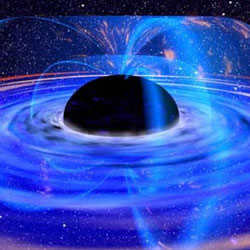
Scientific Research
Undoubtedly, the oceans are expansive and the mountains reach staggering heights. Additionally, the population of 7 billion people who call Earth home is also an incredibly large number. However, existing within this world with a diameter of 12,742 kilometers, it is easy to overlook the fact that it is relatively minuscule in comparison to the vastness of space. When we gaze up at the night sky, we come to the realization that we are merely a speck of dust in an infinite Universe. We invite you to familiarize yourself with the most colossal entities in the cosmos, some of which are so immense that their size is nearly unimaginable.
1) Jupiter
The biggest planet in the solar system (142,984 kilometers across).
Jupiter is the largest celestial body in our solar system. This planet was named after Jupiter, the supreme deity in Roman mythology. Positioned as the fifth planet from the Sun, Jupiter’s atmosphere is composed of 84 percent hydrogen and 15 percent helium. Additionally, it contains traces of acetylene, ammonia, ethane, methane, phosphine, and water vapor.

Jupiter, with a mass 318 times that of Earth and a diameter 11 times larger, holds 70 percent of the total mass of all the planets in the solar system. Its volume is so vast that it could accommodate 1,300 planets similar in size to Earth. While Jupiter has 63 confirmed satellites, the majority of them are minuscule and indistinct.
2) The Sun
The biggest thing in the solar system (1,391,980 kilometers across)
The Sun is a yellow dwarf star, and it’s the largest thing in the star system we live in. It contains 99.8 percent of the mass of this whole system, with Jupiter making up most of the rest. Right now, the Sun is made up of 70 percent hydrogen and 28 percent helium, and the rest of its mass is only 2 percent.

As time goes on, the hydrogen within the core of the Sun undergoes a transformation and becomes helium. The conditions within this core, which accounts for 25 percent of the Sun’s diameter, are incredibly extreme. The temperature reaches a staggering 15.6 million Kelvin, while the pressure reaches an astonishing 250 billion atmospheres. The Sun’s immense energy is generated through a process called nuclear fusion. In just one second, around 700,000,000,000 tons of hydrogen are converted into 695,000,000,000 tons of helium, along with an additional 5,000,000,000 tons of energy in the form of gamma rays.
3) The Solar System we have
15*10 12 kilometers across
The Solar System we have consists of only one star, which serves as the central object, and nine significant planets – Mercury, Venus, Earth, Mars, Jupiter, Saturn, Uranus, Neptune, and Pluto. Additionally, it includes numerous satellites, millions of solid asteroids, and billions of icy comets.
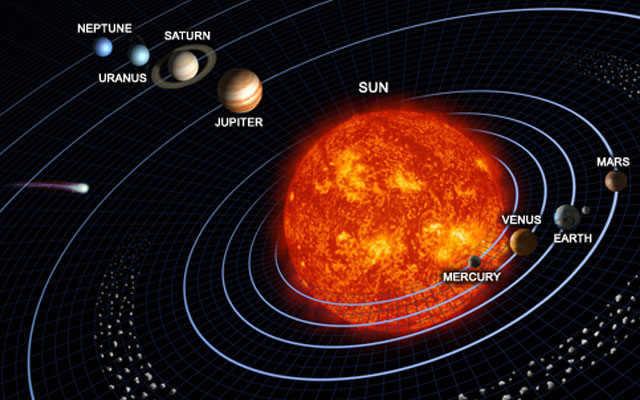
4) VY Big Dog star.
The most immense star in the cosmos (measuring 3 billion kilometers across)
VY of the Big Dog is renowned as the most colossal star and one of the most radiant stars visible in the heavens. It is classified as a red hypergiant and can be found in the Big Dog constellation. This star boasts a radius approximately 1800-2200 times that of our Sun, with a diameter spanning around 3 billion kilometers.
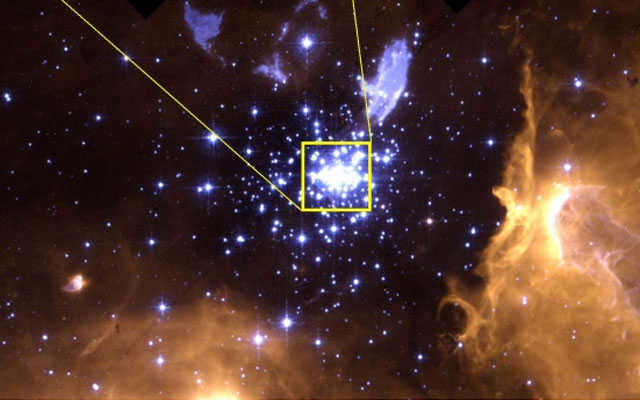
If this star were to be located in our solar system, it would encompass the entire orbit of Saturn. Some astronomers speculate that VY is actually smaller, approximately 600 times the size of the Sun, and would therefore only extend to the orbit of Mars.
5) Enormous water reserves
Astronomers have made the remarkable discovery of the largest and most substantial reserves of water ever detected in the entirety of the Universe. The colossal cloud, estimated to be around 12 billion years old, contains a staggering 140 trillion times more water than the combined volume of all the oceans on Earth.

A supermassive black hole, situated 12 billion light-years away from our planet, is encircled by a cloud of gaseous water. Scientists have found that water has been prevalent in the cosmos throughout its entire history, according to this groundbreaking revelation.
6) Incredibly Enormous and Immense Black Holes
21 billion times the mass of our Sun
Supermassive black holes are the most colossal black holes present in a galaxy, with a mass ranging in the hundreds or even thousands of millions of times the mass of our Sun. Scientists believe that most, if not all, galaxies, including our very own Milky Way, harbor supermassive black holes at their cores.

An egg-shaped vortex of stars exists in the galaxy NGC 4889, which is the brightest galaxy in a vast cluster of thousands of galaxies. This colossal monster is 21 million times more massive than our Sun and is situated approximately 336 million light-years away in the constellation Veronica’s Hair. The remarkable aspect of this black hole is its immense size, being 12 times larger than the diameter of our Solar System.
7) The Milky Way
About 100,000 to 120,000 light years wide.
The Milky Way is a turbulent spiral galaxy that harbors between 200 and 400 billion stars. Numerous planets orbit around each of these stars.

According to certain calculations, there are around 10 billion planets situated in the habitable zone, encircling their parent stars, where all the necessary conditions for the emergence of life similar to Earth’s are present.
8) El Gordo
The most massive galaxy cluster (2*10 15 solar masses)
El Gordo is positioned over 7 billion light years away from our planet, meaning that what we perceive at the moment is merely an early stage of its existence. As per the findings of scientists who have examined this galaxy cluster, it is the largest, hottest, and emits the most radiation compared to any other known cluster at the same distance or even farther away.

The central galaxy located in the core region of El Gordo is remarkably luminous and exhibits an uncommon blue radiance. The researchers conducting the study propose that this extraordinary galaxy is the outcome of the collision and fusion of two separate galaxies.
By utilizing the Spitzer Space Telescope and optical imagery, scientists have approximated that approximately 1 percent of the cluster’s overall mass is comprised of stars, while the remaining majority consists of hot gas that fills the interstellar space. This proportion of stars to gas bears resemblance to the ratio observed in other immense clusters.
Size – 156 billion light years
Obviously, determining the precise dimensions of the cosmos has proven to be an elusive task. However, various calculations suggest that its vast expanse spans a staggering 1.5*10,24 kilometers in diameter. The notion of an ultimate boundary seems unfathomable to us, considering the Universe’s inclusion of awe-inspiring celestial entities:

The diameter of the Sun is approximately 1.39 million kilometers.
The size of the solar system is about 29.9 billion kilometers or 0.0032 light-years.
The distance from the Sun to the closest star is approximately 4.5 light-years.
The Milky Way galaxy spans approximately 1.51 trillion kilometers or 160,000 light-years.
The local group of galaxies has a size of approximately 31 trillion kilometers or 6.5 million light-years.
The local supercluster has a size of approximately 1.2 sextillion kilometers or 130 million light-years.
10) Multilayer
It is possible to envision a scenario where not just one, but multiple Universes coexist simultaneously. The concept of a Multiverse, or Multiple Universe, encompasses the idea of countless potential Universes, including our own, which collectively encompass everything that currently exists or could potentially exist. This includes the entirety of space, time, matter, energy, as well as the physical laws and constants that govern them all.

Nevertheless, there is no concrete evidence to support the existence of universes other than our own, making it highly probable that our universe is unique.
This is the recommended definition for popular science literature. In professional literature, parsecs and larger units such as kilo- and megaparsecs are commonly used to represent vast distances instead of light-years.
Prior to 1984, a light-year was defined as the distance light travels in one tropical year, specifically the epoch 1900.0. The new definition differs from the old one by approximately 0.002%. However, since light-years are not typically employed for precise measurements, there is no practical distinction between the old and new definitions.
Other Units Associated with Light Speed
The following units are not commonly used and are typically only found in popular publications:
- 1 light second is equal to exactly 299,792.458 kilometers
- 1 light minute is approximately 18 million kilometers
- 1 light hour is approximately 1,079 million kilometers
- 1 light day is approximately 26 billion kilometers
- 1 light week is approximately 181 billion kilometers
- 1 light month is approximately 790 billion kilometers
Light Years as a Measure of Distance
The light-year serves as a useful means of illustrating the vastness of astronomical distances.
| Seconds | 4.710-8 | The average distance to the Moon is approximately 380,000 km. This implies that it takes around 1.3 seconds for a ray of light emitted from the Earth’s surface to reach the Moon’s surface. |
| Minutes | 1.6×10-5 | One astronomical unit is equivalent to approximately 150 million kilometers. Hence, it takes about 500 seconds (8 minutes and 20 seconds) for light to travel from the Sun to the Earth. |
| Hours | 0.0006 | The average distance from the Sun to Pluto is around 5 light hours. |
| 0.0016 | The Pioneer and Voyager missions, which have ventured outside the solar system, have traveled approximately one hundred astronomical units from the Sun in the roughly 30 years since their launch. Their response time to Earth’s requests is approximately 14 hours. | |
| Year | 1.6 | The inner edge of the hypothetical Oort cloud is situated 50,000 a. e. from the Sun, while the outer edge is 100,000 a. e. To traverse the distance from the Sun to the outer edge of the cloud, light would take about a year and a half. |
| 2.0 | The maximum radius of the region influenced by the Sun’s gravity (“Hill’s Sphere”) is roughly 125,000 a. f. e. | |
| 4.22 | Proxima Centauri, the closest star to us (excluding the Sun), is situated at a distance of 4.22 sv. years. | |
| Millennium | 26,000 | The center of our Galaxy is approximately 26,000 light years away from the Sun. |
| 100,000 | The diameter of our Galaxy’s disk is 100,000 light years. | |
| Millions of years | 2.5×106 | M31, the famous Andromeda Galaxy, which is the closest spiral galaxy to us, is situated 2.5 million light-years away. |
| 3.14×106 | The Triangle Galaxy (M33) is 3.14 million light-years away and is the most distant stationary object visible to the naked eye. | |
| 5.9×107 | The Virgo cluster, the nearest galaxy cluster, is 59 million light-years away. | |
| 1.5×108 – 2.5×108 | The Great Attractor gravitational anomaly is situated 150-250 million light-years away. | |
| Billions of years | 1.2×109 | The Great Wall of Sloan, one of the largest structures in the Universe, spans approximately 350 Mpc. It would take about a billion years for light to travel from one end to the other. |
| 1.4×1010 | The size of the causal region of the Universe. Calculated from the age of the Universe and the maximum speed of information transmission – the speed of light. | |
| 4.57×1010 | The distance associated with the Earth to the edge of the observable Universe in any direction; the associated radius of the observable Universe (within the standard Lambda-CDM cosmological model). |
Galactic distance scales
- An astronomical measurement with high accuracy equivalent to 500 light seconds, indicating the time it takes for light to travel from the Sun to the Earth, approximately 500 seconds.
Related Topics
References
Additional Information
Wikimedia Foundation . 2010 .
Discover the meaning of “Light-year” in different dictionaries:
LIGHT YEAR – a unit of length used in astronomy that represents the distance light travels in one year outside of our solar system. 1 Light Year = 0.3068 parsec = 9.4605 1015 meters. Physical Encyclopedic Dictionary. M.: Soviet Encyclopedia. Editor-in-chief A. M. Prokhorov…. … Physical Encyclopedia
LIGHT YEAR – The LIGHTY YEAR is a unit of astronomical distance that represents the distance light travels in outer space or in a vacuum within one tropical year. One light-year is equivalent to 9.46071012 km … according to the Scientific and Technical Encyclopedic Dictionary
LIGHT YEAR – The LIGHT YEAR is a unit of length specifically used in astronomy to measure the distance light travels in one year, which is approximately 9.466?1012 km. For example, the distance to the nearest star, Proxima Centauri, is around 4.3 light-years. The most distant stars in the Galaxy are located at… … as stated in the Modern Encyclopedia
LIGHT-YEAR – The LIGHT-YEAR is a unit used to measure interstellar distances, representing the path that light travels within a year, equivalent to 9.46?1012 km … according to the Large Encyclopedic Dictionary
Light-year – A unit of length used in astronomy, the light-year is defined as the distance that light travels in one year. This is equivalent to approximately 9.466 x 10^12 kilometers. The light-year is commonly used to measure vast distances in space. For example, the distance to the nearest star, Proxima Centauri, is approximately 4.3 light-years away. The most distant stars in our galaxy are even further away, spanning billions of light-years.
Light-year – A unit of length used in astronomy, the light-year represents the distance that light can travel in the span of one year. It is equivalent to about 9.4605 x 10^12 kilometers or 0.307 parsecs. The light-year is a non-system unit commonly used by astronomers to measure interstellar distances.
Light year – The light year is a unit of measurement used to describe interstellar distances. It is defined as the distance that light can travel in one year, which is approximately 9.46 x 10^12 kilometers. The light year is often used to convey the vastness of space and the enormous distances between celestial objects.
Light-year – a measurement of distance that represents the distance traveled by light in one year. It is equivalent to 0.3 parsecs … Concepts of Modern Natural Science. Dictionary of basic terms
Throughout centuries, mankind has been continuously developing various systems to measure distances on Earth. As a consequence, the decision was made to establish the meter as the standard unit of length and to use kilometers as the preferred unit for measuring longer distances.
However, as the twentieth century approached, humanity faced a new dilemma. Individuals started to meticulously examine the cosmos – only to discover that the expansiveness of the Universe is so immense that kilometers are inadequate in this context. While conventional units can still convey the distance from Earth to the Moon or from Earth to Mars, attempting to calculate the number of kilometers that separate our planet from the nearest star yields an astronomical figure with an unfathomable number of decimal places.
What does the term “light-year” represent?
It was evident that the exploration of space necessitated a new unit of measurement, which resulted in the introduction of the light-year. In just one second, light can travel a distance of 300,000 kilometers. A light-year – represents the distance that light can cover within the span of a year – and to put it in more conventional terms, that amounts to a staggering 9,460,730,472,580.8 kilometers. Evidently, it is far more convenient to utilize the concise terminology of “one light-year” rather than having to deal with this immense figure in calculations every single time.
Proxima Centauri, which is a mere 4.22 light-years away, is one of the closest stars to us. While this may seem like a vast distance in terms of kilometers, it pales in comparison to the staggering 2.5 million light-years that separate our galaxy, the Milky Way, from the nearest galaxy known as Andromeda. In light of this perspective, Proxima Centauri truly becomes a remarkably close neighbor.
How many Earth years are in 1 light-year?
There is a common misconception that a light-year is a unit of time. However, this is not the case. The term “light-year” actually refers to the distance that light travels in one Earth year, and has no correlation with terrestrial years.
When it comes to measuring vast cosmic distances, it can be challenging to use units like kilometers or miles. As a result, scientists have sought alternative units of measurement. One such unit that is often mentioned in science fiction movies and books is the light-year. However, not everyone understands what this term signifies and how it differs from a regular Earth year.
A light-year is a popular unit of measurement for cosmic distance. It is determined by the distance that light travels in one year, and is used in various scientific calculations and discussions.
The absence of any gravitational fields is a crucial requirement for this calculus to be valid. This requirement is met in vacuum, where the speed of propagation of electromagnetic rays remains constant.
In the 17th century, scientists were engaged in determining the velocity of light. Prior to this, astronomers believed that light propagated through space instantaneously. However, this assumption was challenged by Galileo Galilei, who set out to calculate the time it takes for a beam of light to travel a distance of eight kilometers. Unfortunately, his experiments proved unsuccessful. Similarly, the research conducted by Danish scientist O. Rømer also yielded no results. Rømer observed a temporal discrepancy in the eclipses of satellites orbiting other planets, which varied depending on the Earth’s position. When the Earth was further away from the celestial body, it took longer for the light rays to reach the Earth’s surface. Despite his observations, Rømer was unable to calculate the speed of light.
In the 18th century, the Englishman James Bradley made an unprecedented calculation of the speed of light. This renowned astronomer estimated its velocity to be approximately 301,000 kilometers per second. In more recent times, utilizing Maxwell’s groundbreaking theory of electromagnetism, scientists have been able to precisely determine the speed of light. This research incorporated cutting-edge laser technologies and considered the effects of refraction. The calculated speed of light was found to be 299,792 kilometers and 458 meters per second. This crucial discovery paved the way for the establishment of a convenient unit of measurement for celestial distances.
The calculation is based on 365 days. If you convert the daily value into seconds, you get 86,400 seconds. And in the total number of specified days, it will amount to 31,557,600.
We have computed the distance that a ray of light covers in one second. Multiplying this by 31,557,600 gives us slightly over 9.4 trillion. This represents the measurement of a light year in kilometers. It signifies the distance that a beam of light would travel in a vacuum within 365 days. It also denotes the distance it would cover if it moved along the Earth’s orbit without the presence of gravitational fields.
Here are some examples of distances calculated using this method:
- A ray of light can travel from the Earth to the Moon in 1 minute and 3 seconds;
- By using this method, we can determine the diameter of our galactic disk in 100,000 years;
- The distance from the Sun to Pluto, measured in light hours, is 5.25 hours;
- It would take 2,500,000 light-years to reach the Andromeda Galaxy from Earth, while the star Proxima Centauri is only 4 light-years away;
- Sunlight takes 8.20 minutes to reach our planet;
- The Center of our Galaxy is located 26,000 light years away from the Sun;
- The Virgo cluster is situated 58,000,000 light years away from our planet;
- Clusters of galaxies have diameters measured in tens of millions of light years.
- The distance from Earth to the edge of the visible Universe was measured to be a maximum of 45 billion light years.
The Significance of this Discovery
By calculating the speed of light, astronomers were able to determine the distances between planets, stars, and galaxies. This revelation highlighted the fact that the light emitted by a star takes time to reach Earth. When observing cosmic objects in the sky, we are actually witnessing the past. For instance, the explosion of a distant planet that occurred hundreds of years ago can only be recorded by scientists today.
Calculating distances within our universe is convenient using this unit of measurement. Less commonly used are hours, weeks, or months. When determining the distance to distant celestial objects, the resulting value becomes enormous. Using such values in mathematical calculations becomes challenging and impractical. Scientists have considered this and have introduced another unit of measurement, the parsec, for astronomical calculations involving large distances. It is more suitable for complex mathematical calculations. A parsec is equivalent to three light-years.
The comparison between light years and Earth years
In our daily lives, we often measure distances: to work, to the nearest store, to another city. We compare different values to appreciate the differences. Many people find the concepts of light years and Earth years similar, if not the same, and have a desire to compare them. However, it is important to first define what we mean by an Earth year. We can define it as the distance traveled by our planet in 365 days. With these parameters, one light year would be equivalent to 63 thousand Earth years.
If we calculate the Earth year in terms of days, it is a unit of time, while a light year represents a distance. Therefore, comparing these values would be meaningless and there is no definitive answer to the question.
This video provides an explanation of the concept of a light year.
If you didn’t find the answer to your question, you can suggest a topic for the authors to cover.
Regardless of the lifestyle we lead and the actions we take, we rely on units of measurement every day. Whether it’s requesting a glass of water, heating our breakfast to a specific temperature, visually estimating the distance to the nearest post office, or scheduling an appointment at a specific time, all of these activities require the use of measurement units.
It’s not only about calculations, but also about measuring different numerical categories like distance, quantity, weight, time, and many more. Numbers play a significant role in our everyday life, and we have become so accustomed to them that they feel like familiar tools. However, what happens when we step out of our comfort zone and come across unfamiliar numerical values? In this article, we will explore the incredible numbers that exist in the universe.
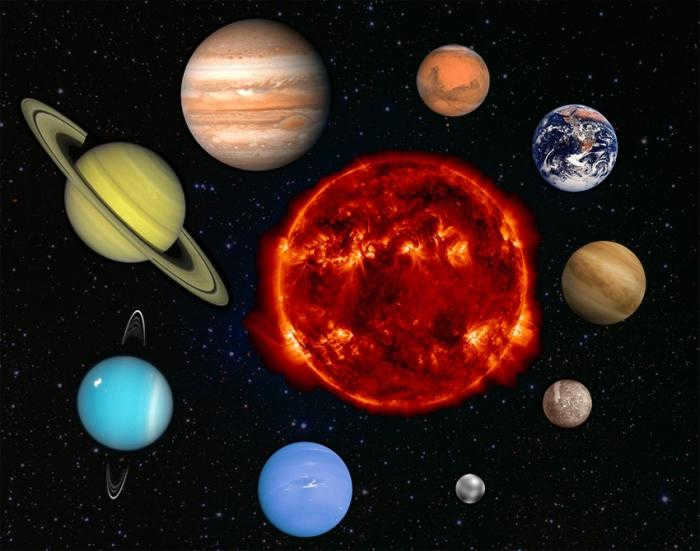
Instead of coming up with a fresh measurement unit, which combines smaller units of measurement (like millimeters, centimeters, meters, kilometers), the decision was made to link distance to time. In fact, time is a physical field that also influences events, furthermore.

As you are aware, astronomers created the astronomical unit as a means to gauge the distances between the Sun and the planets, as well as the distances between planets. But what exactly is a light-year?
First and foremost, it is important to emphasize that the light-year is also a unit of measurement utilized in astronomy, albeit not for time (despite what its name might suggest), but rather for measuring distances.
When scientists were able to determine the distances to the closest stars, it became evident that the astronomical unit was not practical for measuring distances in the stellar realm. To illustrate this, let’s consider the distance from the Sun to the nearest star, which is approximately 4.5 light-years. This means that it takes light from our Sun about 4.5 years to reach the nearest star, known as Proxima Centauri. The enormity of this distance is astounding. Instead of delving into the intricacies of the calculations, let’s simply acknowledge that light particles travel at a speed of 300,000 kilometers per second. For instance, if you were to send a beam of light from a flashlight to the Moon, it would reach its destination in less than a second and a half. On the other hand, it takes approximately 8.5 minutes for light to travel from the Sun to the Earth. Now, let’s consider how far light can travel in the span of a year.
Let’s be honest: the distance of a light-year is approximately 10 trillion kilometers. (a trillion is a number with twelve zeros). To be more precise, it is 9,460,730,472,581 kilometers. If we convert it to astronomical units, it would be roughly 67,000. And this is only the distance to the closest star!
Clearly, in the realm of stars and galaxies, the astronomical unit is not convenient for measurements. It’s more convenient to use light-years in calculations.
Relevance in the celestial realm
As an illustration, consider the distance between Earth and the most luminous star in the sky, Sirius, which amounts to 8 light-years. Additionally, the distance between the Sun and Polaris is roughly 600 light years, meaning that it takes 600 years for light to travel from us to that point. In astronomical terms, this equates to approximately 40 million astronomical units. To put this into perspective, our Galaxy, known as the Milky Way, has a diameter of about 100,000 light years. Furthermore, our closest neighboring galaxy, the Andromeda Nebula, is situated 2.52 million light years away from Earth. Expressing this distance in astronomical units proves to be quite cumbersome. However, there are celestial objects in the Universe that are located at a staggering distance of 15 billion light years from us. This implies that the radius of the observable Universe is 13.77 billion light years. It is worth noting that the entire Universe extends far beyond the observable portion that we are aware of.
By the way, the radius of the observable Universe is not simply twice the diameter. This is due to the fact that the universe is constantly expanding. The objects that emitted light 13.77 billion years ago have since moved even further away from us. In fact, they are now more than 46.5 billion light-years away. If we double that, we get a true diameter of 93 billion light-years for the observable Universe. As a result, the size of the observed portion of the cosmos, also known as the Metagalaxy, is constantly increasing.
It doesn’t really make sense to measure these distances in kilometers or astronomical units. Even light-years don’t quite do justice to the scale of these numbers. However, so far, no better unit of measurement has been devised. The distances are so enormous that only computers can handle them.
The definition and essence of a light year
Therefore, a light year (abbreviated as ly) is a unit of length, not time. It represents the distance that a beam of light travels in one year, equivalent to 365 days.
This measurement unit is highly convenient due to its clarity. It enables us to determine the time it would take for an electromagnetic message to reach a specific star. If this time period is excessively long, such as a thousand years, then it becomes pointless to undertake such actions.
As humans explored their planet, they found the need for different units of measurement for distances and lengths. Initially, these measures were not very accurate because different cultures had their own unique ways of measuring. However, in 1791, French scientists introduced a measure that is still widely used today – the meter (derived from the Greek word “metron” meaning “measure”).
However, as the 20th century began, people started to focus their attention on studying the vastness of the cosmos. They soon realized that the existing metric system was not suitable for measuring the astronomical distances found in the universe. While it is possible to measure the distance from Earth to the Moon or Mars in kilometers, when it comes to other planets or even stars, the numbers would be astronomical with an unimaginable amount of zeros.
That is when scientists decided to introduce the concept of “light years”.
Within a single second, photons of light cover an incredible distance of 300,000 kilometers. This measurement is commonly referred to as a light year, which represents the distance light travels in the span of 12 months. To put it into perspective, this equates to approximately 9,460,730,472,580.8 kilometers or 9.46 x 10^15 kilometers.
While the term “light years” is more convenient for expressing such vast distances, it’s important to note that approximate values are also available for smaller units of time:
1 light second is roughly equivalent to 300,000 kilometers.
1 light minute corresponds to approximately 18 million kilometers.
1 light hour can be estimated as 1,080,000,000,000 kilometers.
1 light day is approximately 26,000,000,000,000,000 kilometers.
1 light week can be approximated as 181,000,000,000,000 kilometers.
1 light month is roughly equal to 790,000,000,000,000,000 kilometers.
What is the limit?
Assuming the spaceship is traveling at the speed of light (approximately 16.8 kilometers per second), it would take 18,000 years to travel one light year. With the Milky Way galaxy being approximately 100,000 light years in diameter, the spaceship would fly for nearly 2 billion years to cross it!
The nearest star to our Sun is Proxima Centauri, which is about four light years away. When converted to kilometers, this distance is incredibly vast.
However, when comparing the distance from Proxima Centauri to the closest galaxy, the Andromeda Nebula, the star seems relatively close. This is because Andromeda is situated 2.5 million light years away from the Milky Way. It would take a spacecraft 35 billion years to reach it.
What other purposes can light years serve?
Utilizing light-years assists in comprehending potential locations in the cosmos to search for intelligent civilizations. This technique aids scientists in determining suitable destinations for transmitting radio signals and those that are not viable options.
Here’s how it operates: the velocity of light matches that of a radio signal, and it transpires that dispatching messages to destinations where they would take thousands or even billions of years to reach is utterly futile. It is logical to seek out “neighbors” by transmitting signals that will traverse a distance equivalent to at least one human lifespan.
What is the equivalent number of Earth years in light years?
It is an erroneous belief that the term “light year” is a measure of time. In fact, a light year is a unit of distance and has no correlation to Earth time. It specifically refers to the distance light travels in one year on Earth. On February 22, 2017, NASA announced the discovery of seven exoplanets orbiting the solitary star TRAPPIST-1. Three of these exoplanets fall within the habitable zone, where liquid water could exist, making it a key condition for life. It was also revealed that this star system is located 40 light years away from Earth. This revelation sparked a significant amount of media attention, with some speculating that humanity was on the verge of colonizing a new star system. However, this is far from the truth. 40 light years is an immense distance, equivalent to an astronomical number of kilometers. The concept of the third space velocity, a term familiar to students of physics, refers to the velocity required for a body near Earth’s surface to escape the solar system. The value of this velocity is 16.65 km/sec. Conventional spacecraft are launched into orbit at a speed of 7.9 km/sec. While it is theoretically possible for modern Earth technologies to achieve speeds of 16-20 km/sec, mankind has not yet mastered the ability to accelerate spaceships beyond 20 km/sec. Let us calculate the amount of time it would take for a starship traveling at 20 km/sec to cover a distance of 40 light years and reach the star TRAPPIST-1.
One light year is defined as the distance traveled by light in a vacuum, and the speed of light is approximately 300,000 kilometers per second. A spaceship created by humans travels at a speed of 20 km/sec, which is 15,000 times slower than the speed of light. Therefore, it would take a ship traveling at this speed 600,000 years to cover a distance of 40 light years. An Earth-made spaceship, based on current technological capabilities, would require approximately 600 thousand years to reach the star TRAPPIST-1! Considering that the existence of modern humans on Earth, according to scientists, is only 35-40 thousand years, this time frame is significantly longer. In the near future, it is unlikely that technology will advance to the point where reaching the star TRAPPIST-1 becomes feasible. Even the most promising engines, such as ion engines, photon engines, and space sails, which do not currently exist in reality, are estimated to only achieve speeds of 10,000 km / s. This would reduce the flight time to the TRAPPIST-1 system to 120 years, which is a more acceptable timeframe for interstellar travel involving cryogenic hibernation or multiple generations of settlers. However, at present, all these engines remain purely theoretical. Even the closest stars are still too distant for humans to reach, let alone stars in our own galaxy or other galaxies. Our Milky Way galaxy spans approximately 100,000 light years, meaning a journey from one end to the other would take 1.5 billion years using current Earth-made spacecraft. Scientific evidence suggests that our Earth is 4.5 billion years old, and multicellular life has existed for approximately 2 billion years. The distance to our closest galaxy, the Andromeda Nebula, is 2.5 million light years from Earth – an unimaginable distance! As you can see, it is clear that no person alive today will ever have the opportunity to set foot on a planet near another star. Despite its name resembling a unit of time, the light year actually measures distance. It is specifically designed to quantify vast distances in the universe.
Calculations and distances
Rephrasing the text to make it unique, while maintaining the HTML markup:
Calculations and measurements
The calculation of a light year is directly connected to the speed of light. In physics, it is commonly considered to be 300,000,000,000 m/s. The precise value of the speed of light is 299,792,458 meters per second. This means that 299,792,458 meters is equivalent to one light second! The distance to the moon is roughly 384,400,000,000 meters, so a beam of light would take around 1.28 seconds to reach the moon’s surface. The distance from the Sun to the Earth is 149,600,000,000,000 meters. Consequently, it takes slightly less than 7 minutes for sunlight to reach the Earth. Therefore, there are 31,557,600 seconds in a year. By multiplying this number by the distance equal to one light second, we find that one light year is equal to 9,460,730,472,580,800 meters. As a result, 1 million light-years would be equal to 9,460,730,472,580,800,000,000 meters. According to rough estimates by astronomers, the diameter of our Galaxy is approximately 100,000 light years. This means that distances measured in millions of light years do not apply within our Galaxy. Such figures are relevant for measuring distances between galaxies.
The distance to the edge of the observable Universe is currently the farthest cosmic distance that can be measured from Earth. It is approximately 45 billion light years. A light-year is a unit of measurement used in astronomy to measure distance.
Numerically, a light-year is the distance that light travels in one year.
More specifically, a light-year is the distance that light travels in a vacuum, unaffected by gravitational fields, over the course of one Julian year (365.25 days or 31,557,600 standard seconds).
In Russian literature, a light-year is represented as “sv. g.”, while in foreign literature it is denoted as “ly”. One light-year is equivalent to:
9,460,730,472,580.8 kilometers.
9,460,730,472,580,800 meters.
63,241.077 astronomical units (a. e.)
0.306,601 parsecs. In addition to the light-year, there are also smaller units of measurement such as the light month, light week, light hour, light minute, and light second. While these units are not commonly used, it is interesting to see how different distances can be expressed in them:
The light-year is a convenient unit of measurement in astronomy because it reflects the fastest speed at which information can travel in our world, which is the speed of light. Therefore, distances expressed in light-years also indicate how quickly one celestial object can influence another. For example, you may have heard that the star Betelgeuse in the constellation Orion is expected to explode in the near future (within a few centuries).
Betelgeuse is located approximately 495 to 640 light years away from us.
If it were to explode right now, the explosion would only become visible to Earth’s inhabitants in 500 to 600 years.
So if you were to witness the explosion today, keep in mind that it actually occurred during the time of Ivan the Terrible.
This example clearly demonstrates the convenience of the light-year as a unit of measurement, as it simultaneously represents both distance and time.
A light year represents the distance traveled by light in one Earth year.
- One light year is equivalent to approximately 9,460,800,000,000,000 kilometers.
- In terms of distance, a month is approximately 788,333 million kilometers.
- A week corresponds to around 197,083 million kilometers.
- A day measures about 26,277 million kilometers.
- An hour is roughly 1,094 million kilometers.
- A minute covers about 18 million kilometers.
- A second spans approximately 300,000 kilometers.
That’s fascinating! It takes around 1.25 seconds for light to reach the Moon from the Earth, while it takes a little over 8 minutes for light to reach the Sun.
The star Betelgeuse, located in the constellation Orion, is expected to explode in the near future.
Betelgeuse is positioned at a distance of approximately 495 to 640 light years from our planet.
In the event of its detonation occurring in the present moment, this cosmic blast would only become visible to Earth’s inhabitants after a span of 500 to 600 years.
So, if you happen to witness this extraordinary event today, bear in mind that the actual explosion took place during the era of Ivan the Terrible…..
Earth year
An Earth year represents the amount of time it takes for the Earth to complete one orbit around the sun. When considering all factors, it can be determined that one light year is equivalent to 63,242 Earth years. It’s important to note that this calculation specifically applies to the planet Earth, as other celestial bodies like Mars or Jupiter would have different values. A light year is a measurement of the distance between two celestial objects. Despite both light years and Earth years representing distance, the numerical values associated with them are significantly different.
Measure
Video
Sources
Many times we receive intriguing inquiries that have unconventional solutions.
One of these inquiries is stated in the title. So, how many years on Earth are equivalent to one light year? Unfortunately, there is no definitive answer.
The reason is that a light year is not a unit of time, but rather a unit of distance. To be more precise, a light year represents the distance that light travels in a vacuum without the presence of gravitational fields, over the span of one Julian year (which is equal to 365.25 standard days or 31,557,600 seconds).
- 1 light month is approximately equal to 788,333,000,000,000 kilometers
- 1 light week is approximately equal to 197,083,000 kilometers.
- 1 light day is approximately equal to 26,277 million kilometers
- 1 light hour is approximately equal to 1,094 million km
- 1 light minute is approximately equal to about 18 million km
- 1 light second is approximately equal to 300 thousand km
To determine the number of kilometers per light-year, you can use a simple web calculator.
Enter the desired number of light years in the left field and the result of the calculation will appear in the box on the right. You can also click on the appropriate link to convert light years or miles to other units of measurement.
What is a “brilliant summer”?
A one-way light year (St., ly) is the distance that light travels in a vacuum in one tropical year (365.25 days).
This term is primarily used in the fields of science and fiction, and within professional circles, the term “kiloparsecs” and “megaparsecs” are commonly used.
It was not until 1984 that the concept of a brilliant year was introduced to measure the distance light travels in a tropical year. Since then, the value has changed by 0.002%, but the practical significance of this difference is minimal due to the lack of precise measurements in relation to brilliant years. The speed of light is approximately 300,000 km/s.
The speed of light is about 300,000 kilometers per second, and a light year is approximately equal to 10 trillion kilometers (or 9,460.8800 million km). When it comes to measuring distances, we can consider the fact that Sirius is located about 8 light years away from the closest point to the star Proxima Centauri, which is approximately 4.22 light years away. Furthermore, the diameter of our galaxy, the Milky Way, is estimated to be around 100,000 light years.
What is a “kilometer”
The kilometer (km) is a unit of measurement for distances and is commonly used worldwide.
A kilometer is equivalent to 1000 meters, 0.621 miles, 1094 yards, 3281 feet, 1.057 x 10^13 light years, and 6.67 x 10^9 astronomical units.
Light years
For centuries, individuals have been devising their own methods of measuring distance in order to explore further and further. As a result, a universal unit of measurement was established – the meter – and distances began to be measured in kilometers.
However, in the twentieth century, a new challenge arose for humanity. As people delved deeper into the study of the universe, it became apparent that the scale of the cosmos was so vast that miles simply couldn’t encompass it.
When using conventional units, it is possible to express the distance between Earth and the Moon, or between Earth and Mars. Yet when attempting to comprehend the distance between our planet and the nearest star, the number “grows” exponentially, stretching across countless decimal places.
It was evident that a new measure of space exploration was necessary – and that measure came in the form of the light-year.
Within a single second, light can travel 300,000 kilometers. A light-year — represents the distance that light can travel in a span of one year, which, when converted to a more familiar numerical system, amounts to 9,460,730,472,580, 8 kilometers. Clearly, the use of the succinct “light-year” is much more convenient than having to use excessively large numbers in calculations.
Out of all the stars in close proximity to us, Proxima Centauri is a mere “4.2 light-years” away. Of course, there is an unimaginable amount of data based on kilometers. However, everything is relative – when considering that the nearest galaxy, Andromeda, is separated from us by a staggering 2.5 million light-years, the star suddenly seems like a very close neighbor indeed.
By the way, the utilization of light-years assists scientists in comprehending the specific areas of the universe where it is plausible to detect intelligent life and identifies the regions where transmitting radio signals would be utterly futile.
Since the velocity of a radio signal is akin to that of light, any salutation dispatched towards a faraway galaxy would take millions of years to reach its intended target. Consequently, it is logical to anticipate a reply from nearby “neighbors” – entities whose hypothetical response signals would reach Earthly apparatuses within a human lifespan.

